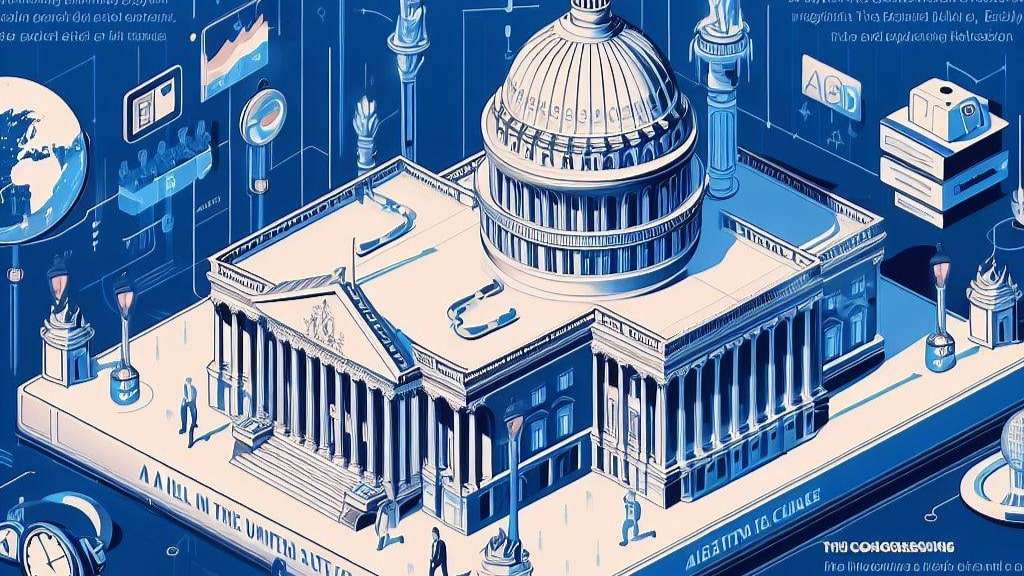
In the age of rapid technological progress, artificial intelligence (AI) stands as one of the most transformative forces shaping our world. It touches every aspect of modern life, from smart homes and self-driving cars to advanced medical diagnostics and predictive analytics. As AI embeds itself deeper into our daily experiences, a crucial question emerges: How should we regulate AI to ensure its ethical and safe deployment?
The United States, home to some of the world’s leading tech companies and innovators, finds itself at a crossroads, balancing the nurturing of innovation with safeguarding its citizens from potential AI-related risks. This article delves into the landscape of AI regulation in the USA, exploring government initiatives, the tech industry’s perspective, and the challenges in crafting a balanced and effective regulatory framework.
The Current State of AI Regulation in the USA
Artificial intelligence, with its vast potential and transformative capabilities, has captured the attention of policymakers in Washington. Recent activities suggest a growing recognition of AI’s implications for society. Capitol Hill has been abuzz with hearings, news conferences, and discussions centered around regulating this burgeoning technology. The White House, too, has not remained passive in this regard. Meetings featuring top tech executives and the announcement of voluntary AI safety commitments by leading technology firms signal the administration’s commitment to charting the country’s path in AI governance. However, many lawmakers and policy experts argue that the USA is just scratching the surface and has a long and intricate journey ahead toward formulating comprehensive AI rules.
Comparison with Europe: A Proactive Approach
Across the Atlantic, Europe has taken a more proactive approach to AI regulation. European lawmakers are on the brink of enacting an AI law this year, which promises to introduce stringent restrictions, especially concerning high-risk AI applications. This swift action contrasts with the USA’s more exploratory approach, where insights are gathered, and the best possible approach is carefully considered. While Europe’s upcoming regulations offer a glimpse into a potential future of tighter AI governance, the USA remains immersed in deliberation, striking a delicate balance between fostering innovation and ensuring safety.
Tech Companies’ Perspective: A Nuanced View
The tech industry, often at the forefront of AI advancements, holds a nuanced view of regulation. On one hand, many tech giants are willing to embrace regulations, recognizing the importance of ethical AI deployment for long-term sustainability. Companies like Microsoft, Google, and OpenAI have even taken proactive steps, showcasing safety measures and principles to guide their AI technologies. However, there’s a catch. While welcoming some form of regulation, these companies oppose overly stringent rules like those proposed in Europe. They argue that extremely tight regulations could stifle innovation, potentially hampering the USA’s position as a global technology leader. This delicate balancing act between ensuring safety and fostering innovation presents a complex challenge for policymakers and the tech industry.
The White House’s Involvement: A Proactive Stance
Central to the USA’s approach to AI regulation has been the proactive stance of the White House. Recognizing both the potential and pitfalls of AI, the Biden administration embarked on an extensive ‘listening tour,’ creating platforms for dialogue and consultation with various stakeholders. These stakeholders include AI companies, academic experts, and civil society groups. One pivotal moment was the meeting convened by Vice President Kamala Harris, where she hosted chief executives from industry giants like Microsoft, Google, OpenAI, and Anthropic. The primary emphasis was on pushing the tech sector to prioritize safety measures, ensuring that the rapid evolution of AI technologies does not come at the expense of user safety and societal ethics.
Voluntary Commitments by Tech Companies: A Positive Step
In a significant move, representatives from seven leading tech companies made their way to the White House, putting forth principles to make their AI technologies safer. These principles included measures such as third-party security checks and watermarking AI-generated content to curb misinformation. While many of these practices, notably from OpenAI, Google, and Microsoft, were already in place or set to be implemented, they don’t necessarily represent new regulatory measures. Despite being a positive step, these voluntary commitments faced critique. Consumer groups pointed out that self-regulation might not be sufficient when dealing with the vast and powerful realm of Big Tech. The consensus? Voluntary measures, while commendable, cannot replace the need for enforceable guidelines that ensure AI operates within defined ethical boundaries.
Blueprint for an AI Bill of Rights: A Vision for Ethical AI
Amidst the whirlwind of discussions, the White House introduced a cornerstone document – the Blueprint for an AI Bill of Rights. Envisioned as a guide for a society navigating the challenges of AI, this blueprint offers a vision of a world where technology reinforces our highest values without compromising safety and ethics. The blueprint lays out five guiding principles:
Congressional Efforts: Navigating the Regulatory Landscape
In addition to executive branch initiatives, Congress has also been actively engaged in addressing AI regulation. Legislators have introduced bills and held hearings to explore various aspects of AI governance. These efforts aim to strike a balance between fostering innovation and safeguarding the public interest. As discussions progress, lawmakers are working toward creating a comprehensive framework that addresses the multifaceted challenges posed by AI.
In conclusion, the USA is navigating the complex landscape of AI regulation with a delicate balance between promoting innovation and ensuring safety and ethics. While Europe takes a proactive stance with forthcoming regulations, the USA treads carefully, emphasizing consultation and dialogue. The tech industry, recognizing the importance of ethics, presents a nuanced perspective, calling for regulation that does not stifle innovation. The White House plays a central role in shaping the AI regulatory landscape, with the Blueprint for an AI Bill of Rights offering a vision for ethical AI. Congressional efforts aim to create a comprehensive regulatory framework that addresses the challenges of the AI era. As AI continues to evolve, finding the right balance in regulation remains a critical and ongoing endeavor.

Get the latest Crypto & Blockchain News in your inbox.